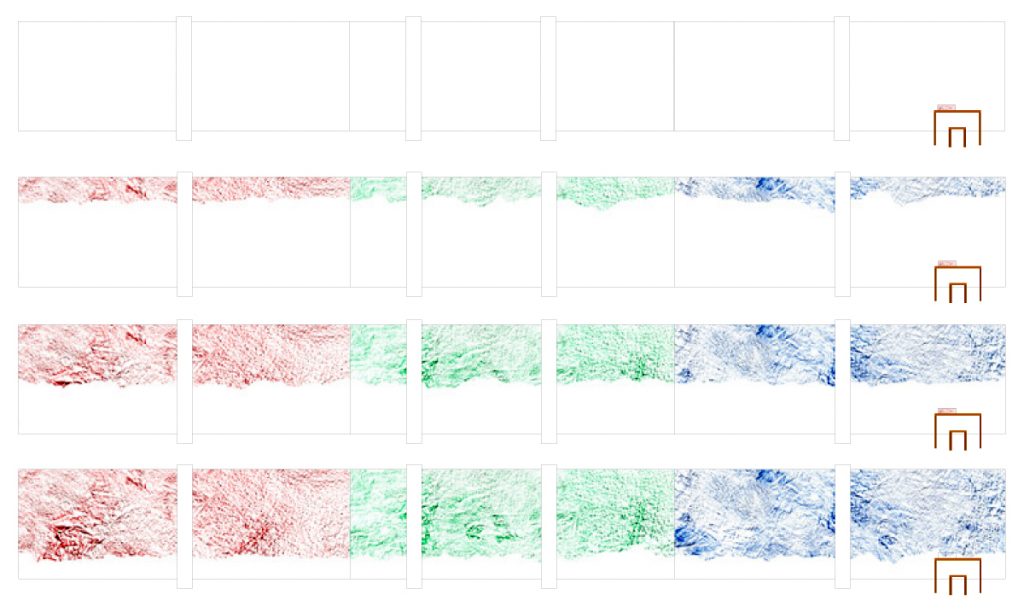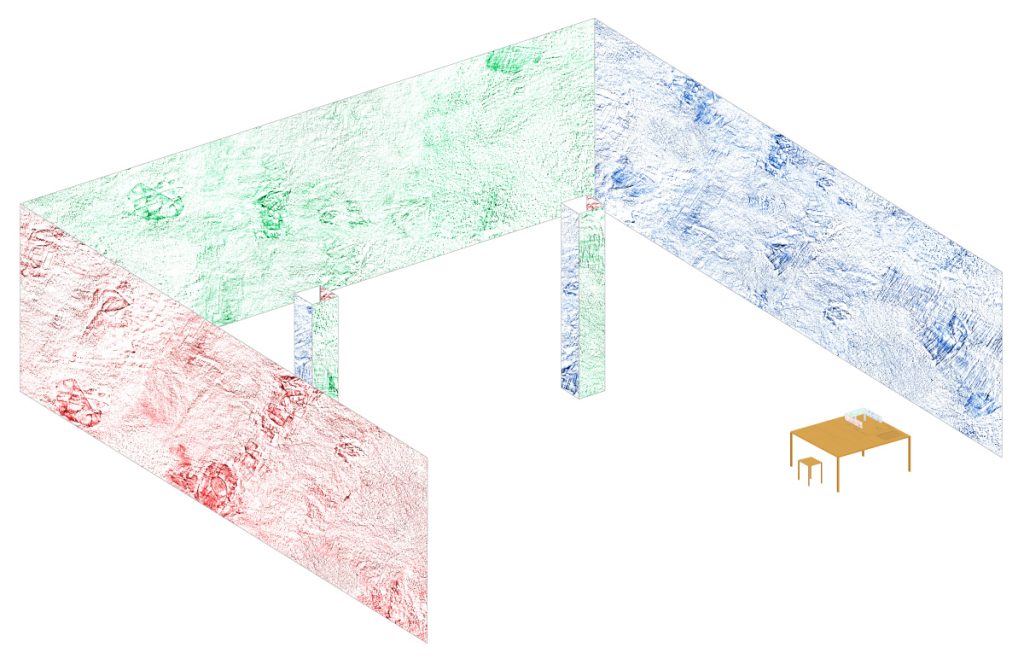
Astracán. Un proyecto para espacio Rambleta. 2021…
Astracán se planteó, aunque nunca se llegó a realizar, como un proyecto dividido en varias fases. Un trabajo de síntesis a medio camino entre la performance, el site specific y la instalación que se hubiese formalizado y accionado a través de un dibujo mural colaborativo.
Como idea Astracán es una reflexión sobre el hecho artístico y su autoría, sobre qué es dibujar, sobre el significado de las imágenes, y nuestra idea de paisaje abordados desde la abstracción.
1. Astracán se hubiese inaugurarado con una mesa-maqueta como único elemento expositivo. Sobre ella un plano a lápiz de Rambleta y sus alrededores, un modelo a escala del dibujo mural en su primera fase y un texto explicativo del proyecto.
Astrakhan. A project for Rambleta space. 2021…
Astrakhan was planned, although it was never realised, as a project divided into several phases. A work of synthesis halfway between performance, site specific and installation that would have been formalised and activated through a collaborative mural drawing.
As an idea, Astrakhan is a reflection on the artistic act and its authorship, on what it is to draw, on the meaning of images, and on our idea of landscape approached from abstraction.
1. Astrakhan would have been inaugurated with a table-model as the only exhibition element. On it a pencil map of Rambleta and its surroundings, a scale model of the mural drawing in its first phase and a text explaining the project.

2. Durante los diez días siguientes se habría llevado a cabo una acción lenta y meditada abierta al público: el frottage de todas las paredes y las columnas de la sala. Un gesto sencillo ejectuado con barras de pastel rojo, verde y azul; los tres colores básicos luz. Tres colores (RGB) cuyas infinitas combinaciones dan como resultado cualquier imagen proyectada.
A modo de catas arqueológicas esta simple operación hubiese hecho visible la textura de la pared, su memoria intangible, las huellas ocultas que otros artistas y otras actividades han dejado grabadas en su superficie. Un mapa cartográfico a escala real y una suerte de paisaje en el que perderse, donde podremos ver tanto como estemos dispuestos a dar. Un panorama que irá del más pequeño accidente topográfico hasta y hacia lo abstracto, lo metafórico y la proyección mental de la mirada.
3. En la sala ya intervenida -y transformada en una suerte de escenografía con las paredes funcionando tanto de fondo como de telón- se hubiese programado el taller Métodos y procesos. Una nueva acción performática con diferentes actores y espectadores.
4. Un gran lienzo en blanco. En eso paradójicamente se transformaría Astracán. Pues durante todo el tiempo que la exposición hubiese permecido abierta sus paredes serían un espacio donde el visitante su podría haber expresado libremente, desdibujando con sus manos mi trabajo, sumando a esas huellas recuperadas y a mi labor nuevas capas, otros gestos, dibujos o palabras; un nuevo paisaje de imágenes, tiempos, acciones e intenciones.
2. During the following ten days, a slow and meditated action open to the public would have been carried out: the frottage of all the walls and columns of the room. A simple gesture carried out with bars of red, green and blue pastel; the three basic light colours. Three colours (RGB) whose infinite combinations result in any projected image.
In the manner of archaeological tastings, this simple operation would have made visible the texture of the wall, its intangible memory, the hidden traces that other artists and other activities have left engraved on its surface. A cartographic map on a real scale and a sort of landscape in which to lose oneself, where we can see as much as we are willing to give. A panorama that will go from the smallest topographical accident to and towards the abstract, the metaphorical and the mental projection of the gaze.
3. In the room already intervened – and transformed into a sort of stage set with the walls acting as both backdrop and curtain – the workshop Methods and Processes would have been programmed. A new performative action with different actors and spectators.
4. A large blank canvas. Paradoxically, this is what Astrakhan would become. For during all the time that the exhibition would have been open, its walls would have been a space where the visitor could have expressed himself freely, blurring my work with his hands, adding new layers, other gestures, drawings or words to those recovered traces and to my work; a new landscape of images, times, actions and intentions.

5. Como epílogo de la exposición la conferencia El paisaje porque sí vendría a cerrar las actividades programadas en la sala.
6. Realizado también por mí, la última fase del proyecto hubiese consistido en el repintado de las paredes para volverlas a su blanco original. Con esta última acción el dibujo no hubiese desaparecido, sino que se habría vuelto invisible, quedando oculto y latente para siempre. Este proceso como todos los anteriores también se habría abierto al público.
En resumen Astracán y todas sus acciones reflexionan sobre el dibujar como actitud -hacerlo bien o hacerlo mal-, sobre la experiencia artística como acto performático; sobre la exposición como un acontecimiento de exploración y expectativas, donde encontrarse, compartir y dejarse llevar. En definitiva una experiencia que nos invita a posicionarnos como espectadores o hacedores, y en el que la autoría se cuestiona y se diluye en el propio desarrollo del proyecto.
5. As an epilogue to the exhibition, the conference The Landscape in Itseflt would close the activities programmed in the hall.
6. Also carried out by me, the last phase of the project would have consisted of repainting the walls to return them to their original white. With this last action the drawing would not have disappeared, but would have become invisible, remaining hidden and latent forever. This process, like all the previous ones, would also have been open to the public.
In short, Astrakhan and all its actions reflect on drawing as an attitude – to do it well or to do it badly – on the artistic experience as a performative act; on the exhibition as an event of exploration and expectations, where to meet, share and let oneself go. In short, an experience that invites us to position ourselves as spectators or makers, and in which authorship is questioned and diluted in the very development of the project.
